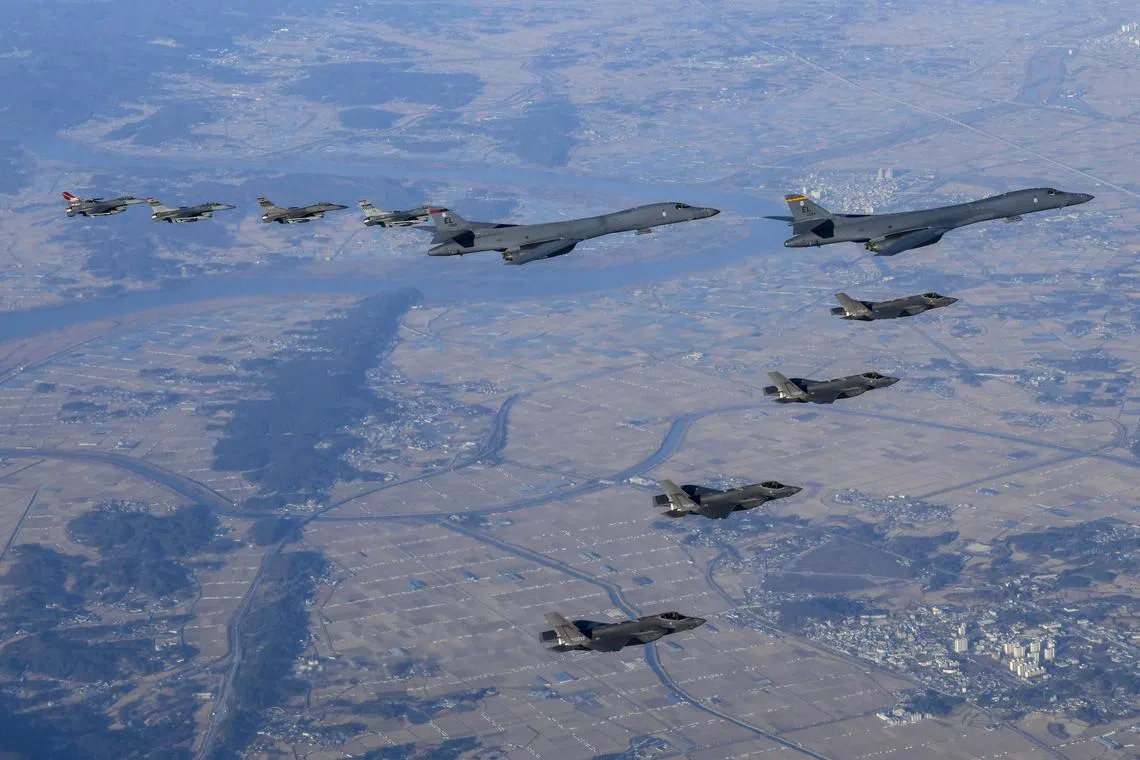North Korea says launches were simulated attack, as South recovers missile parts
Sign up now: Get ST's newsletters delivered to your inbox

Two US Air Force B-1B bombers, escorted by a squadron F-16 and F-35 fighter jets, during joint war drills dubbed "Vigilant Storm".
PHOTO: EPA-EFE
Follow topic:
SEOUL - North Korea said on Monday that its recent missile launches were simulated strikes on South Korea and the United States, as the two countries held a “dangerous war drill”
Last week, North Korea test-fired multiple missiles,
The North’s military said the Vigilant Storm exercises were an “open provocation aimed at intentionally escalating the tension” and “a dangerous war drill of very high aggressive nature”.
The North’s army said it had conducted activities simulating attacks on air bases and aircraft, as well as a major South Korean city, to “smash the enemies’ persistent war hysteria”.
The flurry of missile launches included the most in a single day, and come amid a record year of missile testing by the nuclear-armed North Korea.
South Korean and US officials have also said that Pyongyang has made technical preparations to test a nuclear device, the first time it will have done so since 2017.
Senior diplomats from the US, Japan and South Korea spoke by phone on Sunday and condemned the recent tests, including the “reckless” launch of a missile that landed off South Korea’s coast last week, according to a US State Department statement.
An official at South Korea’s Joint Chiefs of Staff said on Monday that a South Korean ship had recovered debris believed to be part of a North Korean short-range ballistic missile that landed off the South’s coast last week.
It was the first time a North Korean ballistic missile landed near South Korean waters.
The South Korean Navy rescue vessel used an underwater probe to recover the parts, which are being analysed, the official said.
The North Korean military said it fired two strategic cruise missiles last Wednesday towards the waters off South Korea’s Ulsan, the south-eastern coastal city housing a nuclear power plant and large factory parks.
South Korean officials called the claim untrue and said they did not track any missiles near the area.
Analysts said some of the photos released by North Korean state media seemed to be recycled from launches earlier in the year.
The operations also included a launch of two tactical ballistic missiles loaded with dispersion warheads, a test of a special functional warhead paralysing the operation command system of the enemy, and an all-out combat sortie involving 500 fighter jets, according to a statement carried by the official KCNA news agency.
Five hundred fighters would represent almost every dedicated combat aircraft in the North’s inventory, which seems unlikely, given that many are 40- to 80-year-old airframes and not all are serviceable or kept in the active fleet, said Mr Joseph Dempsey, a defence researcher at the International Institute for Strategic Studies.
“The 500 figure seems exaggerated or at least misleading,” he said in a post on Twitter.
The General Staff of the North’s Korean People’s Army (KPA) accused Seoul and Washington of eliciting a “more unstable confrontation”, and vowed to counter their drills with “sustained, resolute and overwhelming practical military measures”.
“The more persistently the enemies’ provocative military moves continue, the more thoroughly and mercilessly the KPA will counter them,” it said in the statement.
The photos released by state media appeared to show a previously unreported new type or variant of ICBM, analysts said.
“It’s not explicit in their statement, but the design doesn’t correspond to one we’ve seen before,” said Mr Ankit Panda, a missile expert at the Carnegie Endowment for International Peace.
He said the launch may have been a developmental platform for evaluating missile subsystems, including possibly a vehicle for multiple independently targetable re-entry vehicles (MIRVs), which allow a single missile to drop nuclear warheads on different targets.
“This is definitely an ICBM-size missile,” Mr Panda said.
Professor George William Herbert, an adjunct professor at the Centre for Nonproliferation Studies and a missile consultant, said the images showed what appeared to be a new nose cone on North Korea’s Hwasong-15 ICBM, which was first tested in 2017.
The nose cone has a different shape, and appears larger than necessary for the 200- to 300 kilotonne nuclear device shown in state media, he said.
Prof Herbert said the shape is more suited for a single, large warhead than multiple smaller warheads such as an MIRV.
Mr Kim has called for the development of both larger nuclear warheads, as well as smaller ones, which could be used in MIRVs or for tactical weapons. REUTERS

